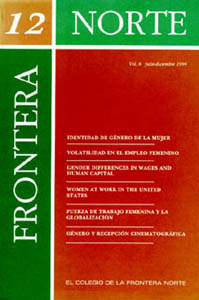Gender Differences in Wages and Human Capital: Case Study of Female and Male Urban Workers in Mexico from 1984 to 1992
Contenido principal del artículo
Resumen
Detalles del artículo
Las/los autoras/es que publiquen en esta revista aceptan las siguientes condiciones:
- Las/los autoras/es conservan los derechos de autor y ceden a la revista Frontera Norte (RFN) el derecho de la primera publicación, mediante el registro de los textos con la licencia de Creative Commons Atribución-No comercial-Sin derivar 4.0 internacional (CC BY-NC-ND 4.0), que permite a terceros utilizar lo publicado siempre que mencionen la autoría del trabajo y a la primera publicación en esta revista.
- Autorizan que su artículo y todos los materiales incluidos en él sean reproducidos, publicados, traducidos, comunicados y transmitidos públicamente en cualquier forma o medio; así como efectuar su distribución al público en el número de ejemplares que se requieran y su comunicación pública, en cada una de sus modalidades, incluida su puesta a disposición del público a través de medios electrónicos o de cualquier otra tecnología, para fines exclusivamente científicos, culturales, de difusión y sin fines comerciales.
- Los autores/as pueden realizar otros acuerdos contractuales independientes y adicionales para la distribución no exclusiva de la versión del artículo publicado en esta revista (por ejemplo: incluirlo en un repositorio institucional, página web personal; o bien publicarlo en un libro) siempre que sea sin fines comerciales e indiquen claramente que el trabajo se publicó por primera vez en Frontera Norte (RFN), [agregando la ficha bibliográfica correspondiente: Autor/es. (año). Título del artículo. Frontera Norte, volumen (número), pp. doi: xxxx ].
Para ello, los autores deben remitir el formato de carta-cesión de la propiedad de los derechos de la primera publicación debidamente llenado y firmado. Este documento debe cargarse en formato PDF en archivos complementarios dentro de la plataforma OJS.

Este obra está bajo una licencia de Creative Commons Atribución-No comercial-Sin derivar 4.0 internacional (CC BY-NC-ND 4.0).
Citas
This is potential experience since it is calculated as age - years of formal schooling - 6. The advantage that male workers enjoy may be underestimated since women workers tend to have less continuous on-the-job experience than male workers.
For a more general discussion of changes in wage differentials in Mexico during this period, see Diana Alarcón and Terry McKinley, "Wage Differentials in Mexico from 1984 to 1992: A Profile of Human Capital and Earnings," paper presented for the Conference on The Impact of Structural Adjustment on Labour Market and Income Distribution in Latin America, San José, Costa Rica, September 7-9, 1994.
These percentages for 1992 are calculated based on a model with monthly wages, rather than the logarithm of monthly wages, as the dependent variable. We used this new model because for all urban workers the semilogarithmic model explained only 8.4 percent of the total variance in wages. For 1992 the standard Mincerian human capital model of wage determination became markedly less useful, in part because the relationship between years of education and the rate of increase in earnings became decidedly more convex and in part because a great deal of the increased variance in wages was not explained at all by differences in human capital among workers.
For a more general discussion of the unexplained nature of wage dispersion under structural adjustment in Mexico, see Terry McKinley and Diana Alarcón, "Widening Wage Dispersion under Structural Adjustment in Mexico," paper prepared for the Conference on The Impact of Structural Adjustment on Labour Markets and Income Distribution in Latin America, San José, Costa Rica, September 7-9, 1994.
For a discussion of issues of comparability between the 1984 and 1989 data, see Diana Alarcón, Changes in the Distribution of Income in Mexico and Trade Liberalization, El Colegio de la Frontera Norte, Mexico, forthcoming.
For the classic statement of a human capital model, see Jacob Mincer, Schooling, Experience and Earnings, Columbia University Press, New York, 1974. An alternative model which is often used to identify changing rates of return to schooling includes dummy variables for each level of education. For a recent example and statistical test, see Christopher R.S. Dougherty and Emmanuel Jiménez, "The Specification of Earnings Functions; Tests and Implications," Economics of Education Review, vol. 10, #2, 1991, pp. 85-98.
A more elaborate model of an earnings function is utilized for 1989 data in Diana Alarcon with Terry McKinley, "The Persistance of Labor Market Segmentation in Mexico in the Aftermath of Economic Restructuring," mimeo, 1994. Because of the inclusion of dummy variables for border states, poor states, urban areas, and gender, as well as other variables, the private rates of return to education are generally lower for this more comprehensive model than those reported in the current paper. A recent illustration of the reduction in estimated rates of return when dummy variables are included for geographical area and economic sector is found in Peter Griffin and Alejandra Cox Edwards, "Rates of Return to Education in Brazil: Do Labor Market Conditions Matter?" Economics of Education Review, vol. 12, #3, 1993, pp. 245-255.
The full expression for the rate of return to education is as follows: a1 + 2a2(mean S) + b1(l) + b2(mean X)(1). Generally this rate of return will be lower than that found for the first two terms since the third term tends to be a large negative relative to the positive fourth term.
See George Psacharopoulos, "Returns to Education: A Further International Update and Implications," Journal of Human Resources, vol. XX, #4, 1985, pp. 583-597; and George Psacharopoulos and Ying Chu Ng, "Earnings and Education in Latin America: Assessing Priorities for Schooling Investments," World Bank Working Papers WPS #1056, Technical Department, Latin America and the Caribbean Region, December 1992
